[title
Crew biographies, photos and mission patch – November 12th]
BIO – Roger G. Gilbertson
PAST
I studied Aerospace at USC, switched to robotics and film/video at Hampshire College. Joined a Silicon Valley startup, then started an internet and robotics business (Mondo-tronics and RobotStore.com) with friends. We contributed a tiny, unique “Muscle Wire” component to the Mars Pathfinder Sojourner Rover. After selling the business to a key supplier, I became the first full time “media guy” at SpaceX, sharing the adventure starting with Falcon 1 Flight 3, through Dragon arriving at the ISS, and the first successful reentry of a Falcon 9 first stage (2007-2014).
Have since worked on various documentary films, new articles, and non-fiction and fiction stories. Some of my research led to a TEDx talk <https://www.youtube.com/watch?v=_HytJn6uaRk> now with more than 1.3 million views.
PRESENT
I’m married, father of four kids now aged 21 to 34. (When they were younger, I got to take each of them to Parent-Child Space Camp.) I live in Los Angeles with my wife, and in March 2023 we returned from a month exploring the history and mysteries of Egypt and Jordan.
MISSION
For our upcoming mission I’m eager to explore the range of projects we have lined up—from the science of life-supporting bacteria, to the sounds of music on the Martian surface.
MARS
I’ve been a huge fan of space exploration and Mars for as long as I can remember. As a Mars Society “Mars Ambassador” I have been developing a series of talks / short videos with the theme “What I Love Most About Living on Mars.” The presentations are given by a Mars settler from the near future when there are around 10,000 humans on the Red Planet. The goal is to make Mars a “real place” in people’s minds, especially today’s youngsters who will lead our settlement efforts.
BIO – Donald Jacques
PAST
I have enjoyed multiple careers over the years: USAF, Ballroom Dance Teacher, Author of three novels, Electrician, Commercial Maintenance. I even had the auspicious opportunity to portray Duckie, the Maintenance Chief for Luna City in an Arizona State University theater production. For the past 10 years I have served as Chief Scientist of EarthSeed, Inc researching Compact Biological Life Support. (www.EarthSeed.Space)
The culmination of the research is the Mobile Analog Space Habitat (MASH), a 40 ft mobile habitat built on a school bus as a living space for one person. It was built to develop the baselines, and foundation for a scalable biological life support system for Earth and Space. The MASH contains kitchen and living quarters, plus a small workshop, and mini-farm (fishpond, garden, chicken coop, algae PBRs, composting toilet, and distillation gray-water recovery).
In December 2022, I retired from my handyman business after 20 years to accept a Site Manager position at MDRS from Jan-Mar of 2023. As Crew Engineer, I come with a solid foundation in the systems that will sustain us during our mission.
I have added an EarthSeed Brochure-MASH.pdf to the group’s shared folder.
PRESENT
My home base is the home of one of my daughters in central Utah. I just completed my 2nd cross-country, shake-out cruise in the MASH. My first stop was the Analog Astronaut Conference held at Biosphere2 near Tucson, AZ where I presented “The Application of Integrated Biological Life Support components in the Analog.”
During the rest of the journey, I visited the Tucson Air Museum, Houston Space Center, had the opportunity to take a swamp tour in Louisiana, helped my friend set up her RV in Waxau, North Carolina, then a two week visit with another daughter and kids in Kentucky, and finally back to Utah.
I hope to complete needed repairs and upgrades in time for our mission in November.
MISSION
Like a few of you, this will be my first opportunity to be part of an analog crew, and I am looking forward to serving, and getting to know you all. It is my hope to bring a prototype of our Biological Life Support unit for testing in the hab environment during the mission.
SPACE AND… OUT THERE
I can remember being glued to the tv as a young boy watching the first lunar landing, and the excitement of that event has been at my core for these many decades. My dream is not to just get… somewhere. My dream is to spend time on each of the following destinations: Moon, Mars, Calypso, Ganymede, and Titan. SpaceX has given us reusable rockets, and made Mars more reachable than ever. It is my belief that we will achieve some form of a star-drive by the time we reach Titan. I want to be on that ship to the stars.
BIO – Elizabeth Jane Cole
PAST
I co-founded a speakers bureau that represents leading thinkers, scientists and artists for public appearances in academic, institutional and experiential arts oriented venues, film, publishing, advisory services and more worldwide (eviltwinbooking.org). Occasionally covered art, technology and robotics for WIRED Magazine, and produced a podcast for the Love and Radio series.
PRESENT
Manage Evil Twin Booking, a speakers bureau that advances new ideas while transforming culture.
Media strategy, concept development and creative consulting for live events and organizations. With collaborators and like-minded organizations, we sometimes develop the concept and scripts and provide media strategy for live events and actions that draw media attention to critical issues, and that have occasionally led to policy changes in domestic and international law.
I’m driven by curiosity to video document the Starship Integrated Flight Test and capture scans of antiquities in upper and lower Egypt with Scott Beibin.
MISSION
I am excited to join MDRS crew 286 as Crew Journalist.
As part of my involvement, I will be documenting the crew’s experiences throughout the analog mission, for the purpose of highlighting MDRS as a resource for researchers and aspiring astronauts alike, to inspire future analog astronauts to stay curious and keep exploring, and inspiring and informing the public about analog astronauts, exploring Mars, and human spaceflight in general. I’m excited to assist with the Green Hab to explore growing edible crops to support physical fitness on future long term space travel.
BIO – Guillaume Gégo
PAST
In a quest to quench my thirst for space-related biological endeavors, as well as a never-ending ambition to become an astronaut, I stumbled upon European Space Agency’s “MELiSSA projet” (Micro-Ecological Life Support System Alternative) during a public conference given 5 years ago by Dr. Baptiste Leroy at the University of Mons while working on a school project.
That steppingstone was what convinced me to continue my projects during a "second last year of secondary school" at SFDCI in Smiths Falls, ON, Canada. While having automotive and programming classes, I worked on the spiritual child of my old project and presented it at the St-Lawrence Regional Science Fair (https://www.owensoundsuntimes.com/news/local-news/gallery-onward-to-mars-by-way-of-fredericton/wcm/b367933a-394f-427b-9a54-a0f1814ed243/amp). To my delight, I got selected to go to the Canada-Wide Science Fair (CWSF 2019) to present my project, which was called "Growing Plants on Mars: A Computer Simulation" (https://www.insideottawavalley.com/news-story/9339320-smiths-falls-high-school-student-headed-to-canada-wide-science-fair-for-out-of-this-world-simulation/).
When I came back to Belgium, I pursued my education at UMons as a biologist while waiting to seize the chance to work on space-related projects. I worked over the summer on ESA’s Astroplant at the Proteomics and Microbiology lab under the supervision of Dr. Ruddy Wattiez, got to teach English and Botany classes as an assistant, and started diving lessons.
PRESENT
5 years after the original MELiSSA conference, I finally managed to get a Master internship position at the MELiSSA Pilot Plant (https://www.melissafoundation.org/page/melissa-pilot-plant#:~:text=The%20MELiSSA%20Pilot%20Plant%20(MPP,in%20Universitat%20Aut%C3%B2noma%20de%20Barcelona) in Barcelona, Spain, from the 6th of February till the 6th of August 2023. I’m now two months in this beautiful endeavor and mainly focusing on these three topics:
Continuous operation of bench-scale bioreactors for urea and organic acid degradation of synthetic urine
Shake flask characterization of the bacterial consortium used in Compartment 3 of the MELiSSA loop
MATLAB + SIMULINK modeling of single-strain kinetics of C3 bacterial consortium
MISSION
I applied to many analogs this year and this will be my second in chronological order, the first one taking place in Poland’s Analog Astronaut Training Center.
The CO2PROT project I will develop during both analogs aims to assess the possibility of:
Using bacteria (L. indica, R. capsulatus…) to remove CO2 from the confined environment of the analog mission. The fixation of CO2 within the bacteria will produce high-protein novel food with other health benefits, while avoiding the loss of organic matter, and also reducing the energy required for CO2 removal.
Assess the feasibility of a bench scale photobioreactor made during the analog mission, with limited control on the axenicity of the bioreactor itself, since the analog is a “scarce” environment with less equipment compared to a fully-fledged lab.
Test out the edibility of the biomass produced if allowed by the analog’s guidelines.
UPDATE: DETAILS OF THE MASTER THESIS
Promoters (scientific-administrative co-supervision): M. Leroy & M. Wattiez
Subject: CO2 fixation by purple bacteria for the production of "Novel Food" for space exploration and terrestrial application: comparison of three electron sources.
Experiments planned:
o Study of the growth of:
o Rhodospirillum rubrum in volatile fatty acids with high electron content (Butyrate/Valerate) = photoheterotrophy. Dimension applied in analogous low-cost missions to add practical added value to the brief. Allows exploration of Novel-food applications for space exploration.
o Rhodobacter capsulatus in the presence of hydrogen = photoautohydrogenotrophy. Laboratory internship in collaboration with Siegfried Vlaeminck (UAnvers) and/or Gabriel Capson-Tojo (Université de Narbonne).
o Rhodovulum sp or Rhodopseudomonas palustris in the presence of electron flow = photoauto "electro "trophy. Laboratory collaboration with Arpita Bose (St. Louis University).
o Comparison of the interest of the three systems (qualitatively and quantitatively) on the following points:
o Biomass composition and characteristics:
o Protein composition: is it close to egg (ideal protein for humans)? Does it vary according to the electron source chosen? Analysis of free or polymerized aa (in total biomass). Via protein assay and aa analyzer.
o Pigment composition: nature via absorbance spectrum analysis (carotenoids and bacteriochlorophyll).
o Lipid composition: quantitative via kits, natural via mass spectrometry.
o Antioxidant composition.
o Additional interest: LDL cholesterol, etc…
o Study of CO2 fixation rates for the three systems, as well as the rate of assimilation of electron sources:
o Efficiency of CO2 metabolism.
o Analysis of other sources of CO2.
o Human respiration in confined spaces
o Biogas 50/50 CO2/Methane from bacterial digestion of agri-food digestate.
o Efficient use of electron source and economic/ecological interest.
o Fatty acids/Industrial molasses.
o Hydrogen.
o Electron flow.
o Justification of the use of these electron sources in the context of:
o Space exploration (CO2 remediation + novel-food).
o Feed production (livestock/pets).
o Food production (human).
o Which system is more profitable?
o Economically/ecologically/food-wise?
FUTURE
Master thesis, PhD and working around the MELiSSA technology + ESA Young graduate trainee programme.
BIO – Scott Beibin
PAST
Space exploration and aerospace engineering have both been deep passions of mine since early childhood. Early in life I picked up hobbies of model rocketry and astronomy. I would also build machines, take apart radios and generally play with electronics. Thanks to encouragement from my parents and teachers, I managed to become an early attendee of Space Camp in Huntsville AL (1984 & 1985). I believed then that I would eventually work in aerospace or the hard sciences based upon my interests, however life ended up taking me along interesting twists and turns.
My academic career focused on Anthropology and Archaeology, however I eventually quit university while I was running my punk / emo / screamo record label, Bloodlink Records. I became more deeply involved in Do-It-Yourself culture, environmental and social activism, collectives and cooperatives, built large puppets for protests, distributed free vegan food in my city, helped start a pirate radio station, and found myself co-founding the Lost Film Festival which I toured around the globe with as the host, presenter and VJ. I eventually co-founded the Evil Twin Booking Agency as a spin off project of Lost Film Fest with Elizabeth Jane Cole where we continue to participate in organizing live speaking events around the globe for a roster of amazing people. In 2009 my interest in the sciences and engineering were rekindled. I put together a new stage performance called Scientists Are The New Rockstars that gave me the impetus to start deeply researching my interests, and dove into developing eco-technologies and open source hardware – including robotic plotters and 3D printers. I also began to design 3D printable buildings intended to be constructed with natural materials – both for earth and offworld. I also began experimenting with surface mount Brain Computer Interface devices and building bicycle powered generators for off-grid electrical production.
PRESENT
Currently, my life is immersed in Liberation Ecotech based creative projects which I use to feed into my primary goal of designing ecologically sound technologies with respect to collectivism and individual freedom (I deeply believe this will be valuable to our human civilization in a changing Earth environment and settlement in Space.) I live off-grid in the city of Philadelphia. My main projects, Mandelbot Ecotech* and AncientScan** have emerged from my traveling science comedy performance I’ve done since 2009 called Groucho Fractal aka Scientists Are The New Rockstars – which features my inventions and has the goal of making STEAM education fun and accessible. I experiment with audio resonance research via my compositional music project, Ptelepathetique. I also contribute to various open source and decentralized tech projects. My multidisciplinary approach to projects has been deeply inspired by minds such as Nikola Tesla, Buckminster Fuller and Gene Roddenberry.
[* Mandelbot Ecotech has produced the Mandelbot SURFA (Scalable Universal Robotic Frame Assembly) and Mandelbot HAB, a 3D ecotecture printer for natural building projects. Other projects within the framework include flying electric vehicles and atmospheric water generation units.]
[** Ancientscan, uses LiDAR, audio recording and spectral analysis with the purpose of reverse engineering the technological feats of past civilizations. ]
MISSION
During MDRS mission 286 I will conduct research on several fronts.
As the acting Crew Astronomer I will be responsible for operating the robotic telescope and doing astrophotography in addition to my crewmates, Roger Gilbertson and Liz Cole.
I plan to conduct research on the behavior of sound in a low air pressure and Carbon Dioxide rich Martian atmosphere. To do this I will be using a custom built software filter that I collaborated on the design of with professional audio engineer, John Knott. The parameters for the filter were sourced from the paper published by NASA in Journal Nature which revealed the findings about acoustics on Mars based upon data gathered by the Perseverance Rover. My research will culminate in a Ptelepathetique concert performed in a valley at sunset during an EVA in which the sound of Mars will be simulated and recorded through our filter. Simultaneously, an unfiltered version will be recorded in order to compare the sounds later. The sounds will be recorded both within the software and using precision microphones that will serve various recording purposes – including the Zylia ZM-1 which will be used to record ambisonically. I will produce a video to talk about the process which will be released on various social media platforms.
In addition to experiments with sound, I will be utilizing my invention, the Mandelbot SURFA2 to print objects using locally found clay and gypsum found in the vicinity of the MDRS. I will also mke vegan snacks for the crew.
I plan to scan the geographic surroundings of MDRS using precision LiDAR, as well as recording sounds by utilizing various microphones and a Geophone – with the goal of contributing data to the ongoing MDRS VR project.
MARS (OR BUST!)
My intense fascination with Mars started as a small child. I remember being intrigued by the photos that came back from the Viking 1 mission. I kept a newspaper clipping of the desolate Mars landscape in my bedroom which fueled my imagination and desire to one day visit the Red Planet. Over the years I would keep up with developments from NASA and other space agencies and wondered if I would be able to visit Mars in my lifetime even though I had not taken the traditional path toward working in aerospace.
While touring with my various projects, I was lucky enough to have friends who worked in the labs at Carnegie Mellon University where I would visit full scale models and prototypes of Mars Rovers Spirit and Opportunity. I was also able to observe the Curiosity and Perseverance Rovers while they were being assembled at JPL. I’ve closely followed development of the Mars-bound SpaceX Starship program and have attended several of the rocket launches. Over the years I have developed an intense desire to spend time on a Mars analog mission and even tried to visit the Hi-Seas research station on Big Island in Hawaii – but it was not to be, due to the eruption of Mauna Loa. Instead of visiting the station I made LiDAR scans of the surrounding volcanic environment near the entrance, which has inspired the LiDAR scanning part of my mission that I will do while at MDRS.
BIO – Hugo Saugier
Born in 1992, I grew up between the French mountains of Vercors and Hautes-Alpes. A few years ago, I looked up at the Pic de Bure astronomical observatory, perched above my village, and I realized the edifying connection between its work on the origins of the world and its involvement in a series of cable car accidents that hit the territory. This sudden awareness in this setting so ordinary to me inspired me with the idea of a first documentary film, La première étoile.
This long-term work gradually arouses in me a curiosity for the stories and representations that we invent to connect to the world, and more particularly the imaginary fantasies that can bring out from situations of isolation. Later, I realized the links between these themes and my personal trajectory, by taking an interest in the visionary thought of my grandfather Claude Chipaux, a wacky aerospace engineer who dreamed of growing plants on Mars, who was also a collector of Malabar images and oranges papers, and trade unionist engaged against one of France’s biggest industrial groups. From there begins Mars Academy, a second film project for which I am preparing to share this experience with you all in the depths of Utah.
Through my audiovisual studies and then in an art school, where I had performance work on the very materiality of the video media, I also consider cinema as an element that can extend and be intertwined in other accomplishments. The creation and the video management in the theater field therefore allow me to link the image to what can come alive outside its frame, in the space and the temporality of the live performance. Finally, I am one of the initiators of Échos, an improvised music festival where the sound is broadcasted by giant horns in a mountain valley with unique acoustics, a device allowing there too a listening that goes beyond the frontality of the concert.
Website (in french) : https://hugosaugier.fr/


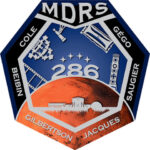
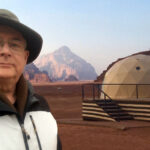
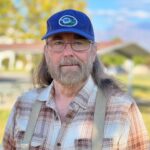
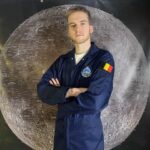
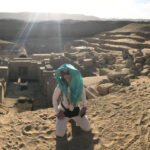
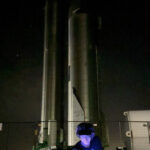
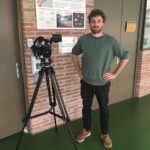
You must be logged in to post a comment.